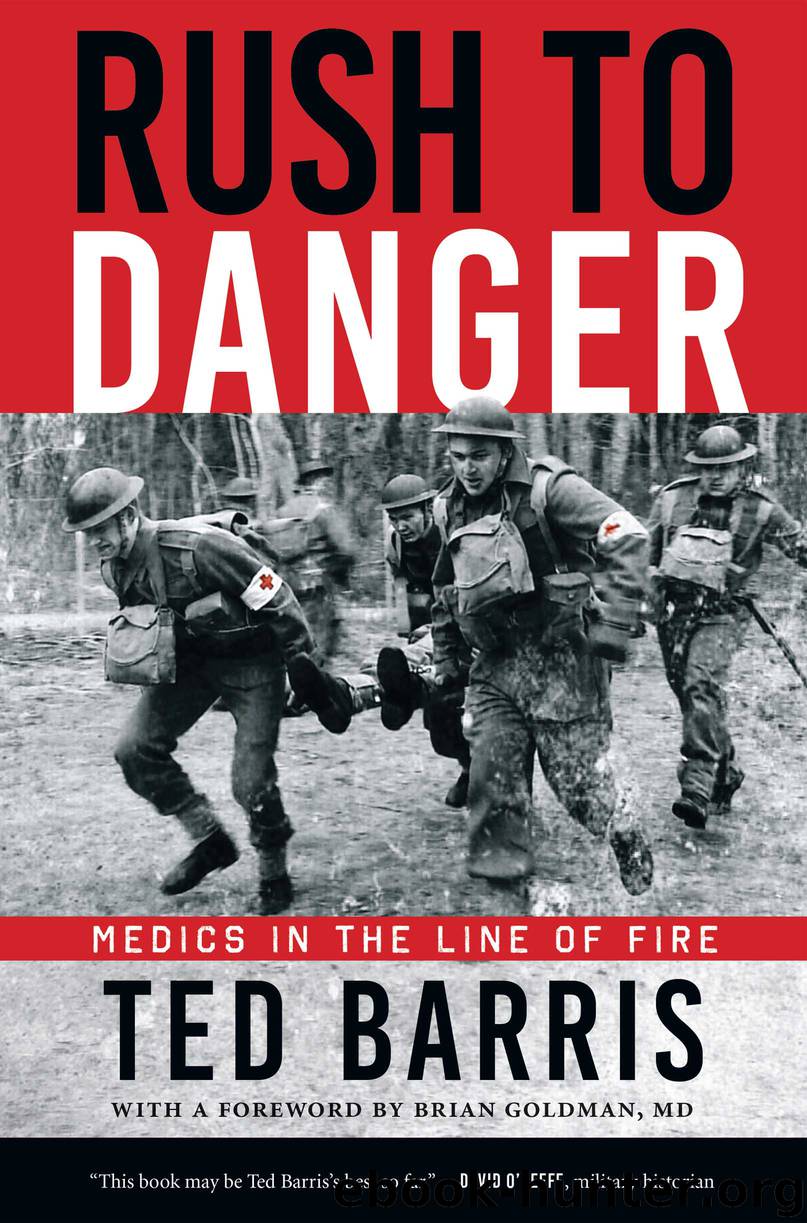Rush to Danger by Ted Barris

Author:Ted Barris
Language: eng
Format: epub
Publisher: HarperCollins Canada
Published: 2019-07-17T16:00:00+00:00
JANUARY 1942—BANGKOK-TO-MOULMEIN RAILWAY, BURMA
EVEN MEDICS WHO EXPERIENCED combat medicine under fire might not agree on whether they felt as if they were targets or not. During the Second World War, news outlets among Allied nations that were prone to propagandize such things chose to vilify German soldiers when they printed the story of Pte. Louis Potts. An American corpsman with the 26th Infantry Division—and clearly wearing his Red Cross helmet and arm bands—Potts dodged sniper fire on Christmas Day 1944, when he entered no man’s land to attend to a wounded GI. Moving to a second casualty, Potts was struck in the forehead by a sniper’s bullet.14 Similarly, news reports on the German side played up the violation of medic immunity with the story of a German Jeep racing through the village of Vierville, France, on D-Day Plus Two. The vehicle carried two wounded men on stretchers lashed to the seats. At first no one responded, because the Jeep was flying a large Red Cross flag. Eventually, however, the Jeep was stopped, the medic shot (allegedly for carrying a pistol), and the two casualties left to die at the roadside.15
During the Battle of the Bulge that began in mid-December 1944, doctors and nurses at the US 77th Evacuation Hospital learned quickly that red crosses on or near their sites meant nothing to an enemy bent on driving perceived invaders from its fatherland. At Verviers, east of Liège, the 77th established a casualty clearing centre for American wounded. As per echelon protocol, doctors and nurses decided then and there how they would attend to incoming casualties. In some cases the medical staff could dress relatively minor wounds and send troops back to front-line duty. In other cases they might tag casualties and send them to a hospital in Liège. At the height of the German offensive, hundreds of American casualties went through the casualty centre, and the triage area took direct hits from German artillery and then strafing runs from Luftwaffe fighter aircraft. More than twenty nurses became additional casualties.16
Arguably, atrocities against medics, surgeons, and nurses occurred most often where the fighting raged between deeply philosophical opposites. A volunteer in the Republican Army during the Spanish Civil War recalled a nursing sister caught in the crossfire between those fighting for the restoration of the monarchy and democratic rule, and the Nationalists intent on replacing the monarchy and its communist sympathizers with a fascist state. The Republican rifleman recalled that the war had hardened him and his comrades in the Mackenzie-Papineau Battalion from Canada and the Abraham Lincoln Brigade from the United States. When a wounded German parachutist fell into Republican hands, the casualty lay on a stretcher unattended until Nursing Sister Carrie approached the injured man and offered him a cigarette. “It wasn’t because we had forgotten the code of the medical corps,” the rifleman wrote, “but because still fresh in our minds was the work of the German flyers that morning.”17
Earlier in the day, he had recorded the entire Republican brigade retreating.
Download
This site does not store any files on its server. We only index and link to content provided by other sites. Please contact the content providers to delete copyright contents if any and email us, we'll remove relevant links or contents immediately.
| Africa | Americas |
| Arctic & Antarctica | Asia |
| Australia & Oceania | Europe |
| Middle East | Russia |
| United States | World |
| Ancient Civilizations | Military |
| Historical Study & Educational Resources |
Underground: A Human History of the Worlds Beneath Our Feet by Will Hunt(11289)
Sapiens by Yuval Noah Harari(4579)
Navigation and Map Reading by K Andrew(4570)
Barron's AP Biology by Goldberg M.S. Deborah T(3646)
The Sympathizer by Viet Thanh Nguyen(3545)
5 Steps to a 5 AP U.S. History, 2010-2011 Edition (5 Steps to a 5 on the Advanced Placement Examinations Series) by Armstrong Stephen(3411)
Three Women by Lisa Taddeo(2931)
The Comedians: Drunks, Thieves, Scoundrels, and the History of American Comedy by Nesteroff Kliph(2798)
Water by Ian Miller(2609)
Drugs Unlimited by Mike Power(2203)
DarkMarket by Misha Glenny(1858)
The House of Government by Slezkine Yuri(1857)
The Library Book by Susan Orlean(1745)
A Short History of Drunkenness by Forsyth Mark(1739)
Revived (Cat Patrick) by Cat Patrick(1687)
The Woman Who Smashed Codes by Jason Fagone(1659)
And the Band Played On by Randy Shilts(1632)
The House of Rothschild: Money's Prophets, 1798-1848 by Niall Ferguson(1624)
Birth by Tina Cassidy(1576)
